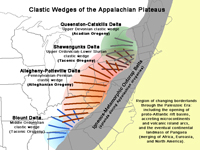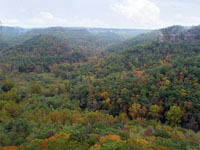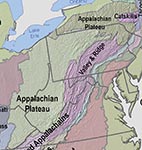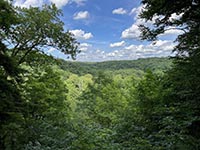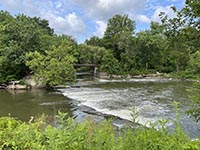|
The Appalachian Plateaus Province is the northeastern side of the greater Appalachian Mountains region (or the Appalachian Basin, the thick underlying sedimentary basin that underlies the Appalachian Mountains region). The Appalachian Plateau Province extends from Alabama to New York (see Figures 21 and 22). The province is subdivided into several separate plateau regions including the Cumberland Plateau (Tennessee-Kentucky), Allegheny Plateau (West Virginia-Pennsylvanian-Ohio), Catskills and Pocono Mountains (New York-Pennsylvania), and Mohawk Plateau (in the Finger Lakes region in upstate New York). These mountainous regions are actually erosionally dissected plateaus, having ridge lines that basically have generally similar elevation throughout. The eastern sides of each of these regions are characterized by a high escarpments that borders the Valley and Ridge Province. The Catskills-Mural Front is a steep escarpment on the east side of the Catskills, overlooking the Hudson River Valley (Figure 36). The Allegheny Front is an east facing escarpment along the Allegheny Mountains in Pennsylvania, Maryland, and West Virginia, and the Cumberland Mountains of southeastern Kentucky form an east-facing escarpment bordering the Valley and Ridge region of western Virginia and eastern Tennessee.
Three mountain-building episodes in the Paleozoic Era resulted in the formation of great regional delta systems that spread westward onto the North American mid continent. These mountain-build periods include the Taconic Orogeny (Ordovician-Silurian time), Acadian Orogeny (Devonian), and Allegheny Orogeny (Pennsylvanian-Permian) (Figures 37 and 38). These orogenies are associated with collisions of smaller landmasses that accreted onto the North American continental margin and the eventual collisions of Africa, Europe, and North America to form the supercontinent Pangaea at the end of the Paleozoic Era. The bedrock of the adjacent Appalachian Plateaus consist of a series of overlapping “clastic wedges” associated with ancient delta systems of rivers that drained from the mountainous highlands that existed to the east along what is now the Atlantic continental margin region (Figure 39).
The ancient delta systems on the western side of the ancestral Appalachian Mountains spread westward, forming broad swamplands and river floodplains that spread into shallow inland seas that covered much of the midcontinent region throughout the Paleozoic Era. These ancient delta-swamplands deposits are host to the extensive coal fields of Pennsylvanian age throughout the Appalachian Plateau region. Deposits from ancient river delta and coastal plains along the interior shallow seaways are host to the coal fields of West Virginia, Kentucky, Indiana, Illinois, and as far west as Missouri and eastern Kansas. Sandstone beds of Pennsylvanian age cap the Cumberland Plateau region, and are well exposed in the Red River Gorge National Geologic Area, Kentucky (Figure 40). |
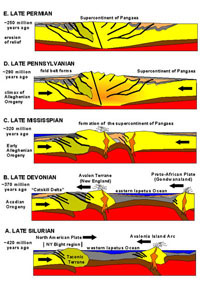 |
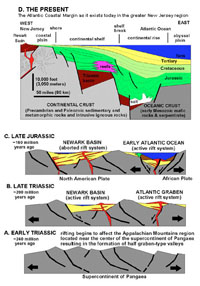 |



